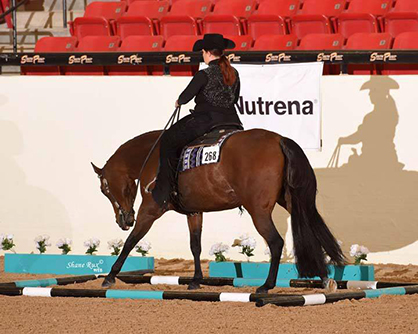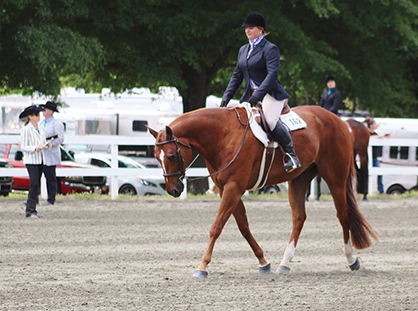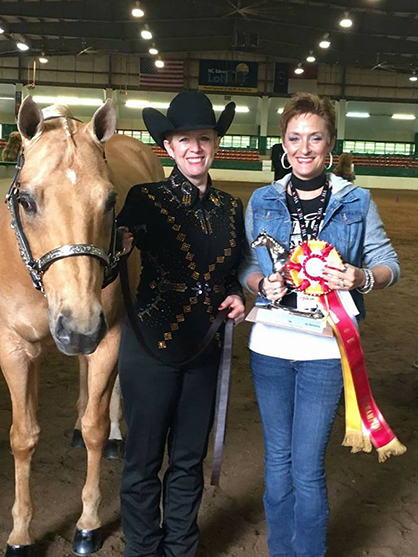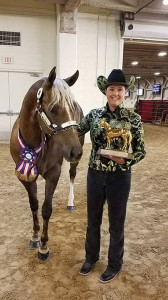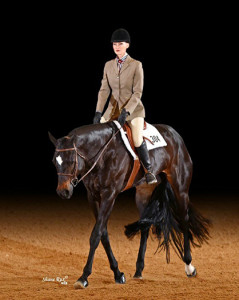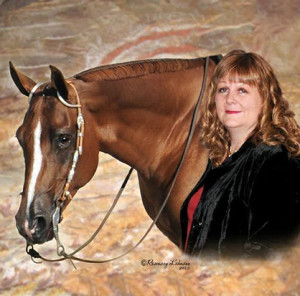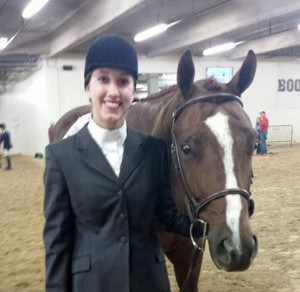Does Eliminating L1 Championship Qualification Make the Event More Inclusive or Less Prestigious?
By: Brittany Bevis
Just in time to mark the conclusion of the final 2017 Level 1 Championship Show, AQHA made the announcement that (beginning in 2018) Level 1 and Rookie exhibitors will no longer need to qualify to compete at the L1 Championships. The change was made after discussion during the April Executive Committee meeting.
According to an AQHA press release, AQHA Chief Show Officer, Pete Kyle, had this to say about the qualification removal for 2018.
“B&W Rookie and Level 1 are the two levels of AQHA competition designed for everyone, from the beginner to the minimally accomplished competitors,” Kyle says. “The Level 1 Championships were designed to celebrate the accomplishments of all of these riders and their horses in an environment that provides education and fun competition. The goal of this change is to give more people and horses the opportunity to compete at the AQHA Level 1 Championships.”
The decision was met with much debate, particularly among the Level 1 exhibitors who competed at the L1 Championships this year. One particular question was posed: does eliminating qualification for the L1 Championships make the event more inclusive or less prestigious?
For L1 Amateur competitor, Alicia Schwartzbeck, who placed in the Top 15 in Showmanship, Aged Geldings, and Rookie Horsemanship at L1 Championships East with her horse, TooSleepyForScotch, she believes qualification removal is a step towards hurting regional show numbers.
“I think it does take away from the prestige of the show,” she says. “There were already two other ways to qualify if you couldn’t show under the (original rule) of 20 judges: by placing in the Top 10 at your regional show and by going through your state club. So, if you couldn’t haul to enough shows, other options were available. Removing the qualification rule also hurts the regional shows. I’ve already been told by fellow competitors that they probably won’t attend their local regional shows now.”
“The L1 classes at the Championships are still very deep, so that requires you to show a certain amount. It also prepares you for the level of competition you will see there, so it’s beneficial to have a requirement. To qualify, I have to make sure I do one show a month from April to September, so I can see how this can be tough for some L1 competitors. I think a good compromise would be making the requirement to be 10 judges. This would make it more inclusive to those who just can’t haul the miles to go, but still retain a level of accomplishment in being invited to go.”
Ericka Schaefer, who showed at the L1 Championships West with her horse, Ok Ima Good One, sees qualification removal as an improvement, but recognizes there are two sides to every issue.
“Personally, I come from a state (Arizona) where the qualifying requirements for the L1 Championships are fairly lax. While it’s a really great feeling the first time you qualify, I don’t think the recognition is nearly as prestigious for us as qualifying in California where it’s a bit tougher. Removing the qualification may remove a little of the prestige of qualifying, but I don’t believe it removes the prestige of the event itself. Without the qualification requirement, the shows will draw a much larger pool of exhibitors. Now, instead of being crowned L1 Champion in a class of 30-35 entries, you might be crowned a champion of a class of 60-70 or more. How cool is that?!”
Melissa Maxwell attended L1 Championships East with her client, Ruth Kaplan, who was named Champion in Select Trail, Select Horsemanship, and Select Equitation, as well as Reserve in Select Showmanship and High Point Select Amateur with her horse, Wish Upon A Lark. Her concerns are directed less at qualification removal as they are about the shows’ location and additional educational opportunities for new competitors that could be considered.
“I think the shows in Las Vegas and Oklahoma City are well spaced enough to accommodate the exhibitors on those perspective coasts. However, I think the show in Raleigh doesn’t provide enough availability to those exhibitors in the northern areas. One exhibitor I spoke to from Canada drove over 30 hours to get there. I’m sure there are many more exhibitors like this young lady who drove extensively to attend last week’s Championship show. I think a show located more north would boost attendance.”
“As to qualifying or not, I think an open attendance format is more beneficial to the program. Level 1 exhibitors are the future of AQHA. If we make that involvement difficult for those potential exhibitors, then we aren’t doing enough for them as an association. I would like to see additional opportunities made available to exhibitors during the show. I had several people give suggestions of what they would like to see. For example, how to instruction on topics like doing a proper bun, trimming their horse, what color to wear on what color horse, or what steps and precautions to take when hauling long distances. It’s a lot of information that’s experience based, but difficult to come by if you’re new to competing at this level. A little outside-of-the-box thinking could go a long way to ensuring AQHA has a following for future generations.”
Ruth Kaplan believes the decision to eliminate qualification will make the show seem less prestigious, might affect the competitive atmosphere of the show, and likely hurt state affiliates. “I was actually very surprised by how underprepared many of the exhibitors were. I’m used to showing in Ohio with a fiercely competitive group of riders. Part of the reason I didn’t go last year is because there was no qualifying required. If there is no qualifying, it will be nothing more than a big open show. If people don’t come to a few AQHA shows to qualify, they aren’t supporting AQHA, and they aren’t going to have the experience to be competitive at a Championship show.”
One compromise Ruth suggests is allowing non-qualifiers to compete only in the Rookie classes, as long as they’re eligible. She also recommended lowering the number of shows to qualify to three, regardless of the number of judges.
“I used to show at the Ohio Palomino shows. When the PHBA World show stopped requiring participants to qualify at the state affiliate shows, it improved their numbers and it killed the state affiliate shows. Ohio used to get 60-100 head at the four shows they held each year. Now they get about 20 head at the one show they hold.”
Katherine Knox is in favor of the qualification removal, but says a compromise wouldn’t be out of the question. “Perhaps we could try five or ten judges instead of 20. We can leave the other qualification methods in place, but by reducing the number of shows an exhibitor has to haul to, we help that person not overextend their budget, and we keep the slightly more elite feel for everyone. This will still provide more incentive for entries at local shows, keeping local affiliates happy.”
“The L1 Championship Show should be used as an attractant and incentive for newer exhibitors to rise within our ranks, in the way that the novice division should be viewed as a stepping stone and not a perpetual purgatory. If there is no place for true novices and rookies to shine and be celebrated, then how do we expect our industry to grow and thrive in today’s economy? Mind you, this isn’t an ‘everyone gets a trophy’ soapbox speech. This is about pure economics and being realistic about the costs of showing and keeping new exhibitors excited about showing for generations to come.”
Katherine cites the change in entries from 2016 to 2017 as proof positive that qualification removal may help increase attendance. “In 2016, after the dates were moved for all shows and the L1 Central Show was created, there was no qualification required for that particular year. Entries went up considerably and provided an incentive for the more genuine novice and rookie exhibitors on a budget to come experience a high profile show. It gave an opportunity to those who might not have had it otherwise. Fast forward one year, and with the yoke of qualifications back on, numbers are down considerably. Some classes only had two exhibitors. Novice Amateur Showmanship entries were down by 40% at the East Coast show.”
Charlotte Chance led her horse, Supernatural Jewel, to win 2-Year-Old Mares at L1 Championships West. Because she solely competes in Halter, she feels the qualification removal is a moot point for her discipline.
“I only show in Halter, so I don’t think qualifying makes a difference to me. You just have to place in the Top 10 at a regional show to qualify for the L1 Championships, and there have never been over three people in any of the classes I have shown in. Not having to qualify just saves me time and money. I was going to have to decide if I took babies to a futurity or if I went to a regional show to qualify for the Level 1 Championships. This way I can do both!”
“It’s not a ‘World Show,’ so I don’t feel the prestige is as high anyway, but it is fun. The people are friendly, facilities are nice, and we always have a great time. I have been three years now and plan on attending next year.”
Trace Thompson competed with her Hunter Under Saddle horse, Dreamin N Blue Jeans, at L1 Championships West. She believes qualification removal is a step in the wrong direction.
“I think AQHA is most definitely taking away the prestige of the L1 Championships by instituting the ‘no qualification’ rule. Last year, while speaking to someone at AQHA, the lady in the office told me it is really a ‘Novice World Show,’ as these classes aren’t offered at the AQHA World Show. So, I was truly thinking they would step things up to officially make it like a Novice World Championship. The reaction I see when people win at the L1 Championships is truly like they won a World title. I’m new showing in the USA, and when I saw the reaction, this got me super excited and motivated to feel part of something prestigious.”
“I think, by taking away the qualification rule, they will possibly lose competitors who are supporting the novice classes at local shows, as they will no longer be chasing qualification points. In turn, a lot of rookies could also flood the novice classes at the L1 Championships, some that haven’t had much experience in the show pen. In my opinion, I think AQHA should’ve gone the other way and stepped up the L1 Championships up to a even more prestigious level, as to make people want to be part of it. People will always chase a goal if they have to work for it. I think, if they were qualifying for a ‘Novice World Championship,’ it would bring so many more people to the shows. It would benefit all shows, with novice youth, amateur, and select riders chasing that qualification and in turn bringing the numbers up at the L1 Championships.”
Betty Allen is in favor of the change, citing the economics of the situation when attempting to show to 20 judges. “I believe it makes it more inclusive. There are a lot of good horses and riders out there who cannot afford to make it to show in front of 20 judges, or who don’t have the time to do so. I’m single and I work full time. I don’t use a trainer, due to an ugly experience, so I have to do it all on my own. As a result, I can’t take off work to travel long distances to hit shows. I have well-bred horses out of Top 10 producing stallions, and their dams have both produced Congress Champions. But, if I had to go to 20 shows, I wouldn’t be able to make the Level 1 shows.”
Stephanie Manhart is disappointed that qualification will not be required for the 2018 L1 Championships. While she understands it’s a step towards inclusivity, she feels a true Championship-level show shouldn’t resort to an open call for competitors.
“I feel that showing to X number of judges or placing in the Top 10 at one show a year isn’t terribly challenging, but it gives people goals. I think the Level 1 classes should be used as a stepping stone to progress a person’s showing ability. Just being able to show up to a Championship show doesn’t seem to be promoting people’s progression or helping the numbers at weekend horse shows.”
“Instead of 20 judges, maybe make it 10. 20 judges does seem intimidating if you’re showing at single-judged horse shows each weekend. This does need to be an attainable goal for level 1 exhibitors, but we do have to remember the real rookies didn’t need to qualify. They were already allowed to enter without qualifying.”
Heather Cote is of a similar mindset that the qualification removal rule will make the show seem less prestigious. “If you take away qualifying, it becomes just another big, expensive horse show. It’s suppose to be a Novice Championship Show. They don’t let everyone show at the AQHA World Show or the Youth World Show. You have to qualify. It should mean something to place at the show. This means knowing you competed against the best of the best.”
“Also, I personally feel that having it at the beginning of the year is ridiculous seeing as how the horse and rider combo rule got thrown out. So, if you’re starting with a new horse, it would be one of the first shows of the year when you’re still getting to know each other. That’s not how I would want to compete at a national level show. AQHA already caters to all novice competitors with the regional championships, so why make showing at a ‘World class’ show so easy?”
For Natalie Boldt, the L1 Championship Show is her favorite event of the year to attend, but she’s not in favor of the change. This year, she attended L1 Championship West where she competed with her horse, Hot Chips R Tuff, placing 5th in Rookie Trail and 9th in Amateur Hunt Seat Equitation.
“To me, a Championship show should be more selective than an open invite, and qualification requirements limit those invites. Whether an exhibitor chooses to show to 20 AQHA judges or place in the Top 10 at a region show, it separates those horse and rider teams who have put in time and effort to get to a Championship show. It’s an accomplishment in itself to make it to the show, and then placing at the show makes it that much more of an award.”
“Since I’m not in favor of the change, a compromise I would suggest would be lowering the number of judges needed to qualify and moving the shows to June to ensure youth exhibitors are out of school. They could also give one more month of qualifying opportunity. The Level 1 Championships are a great way for novice teams to compete and be rewarded for their accomplishments. I’m thankful to compete and give my opinion about the show.”
Shannon Fisher attended the L1 Championships East this year, and she has seen the entries fluctuate over the past few years.
“Last year, the numbers were the largest I’ve even seen. While this year, the number were definitely down. I know there were lots of people that qualified but just didn’t attend. Now as to why they didn’t attend, I’m not sure, but last year’s numbers may have been slightly overwhelming to some. As far as not having to qualify for the 2018 show, I really don’t think this will make it a less prestigious show. I mean, look at the All American Quarter Horse Congress. It’s the largest breed show there is, and it’s not a qualifying show.”
“Also, the focus needs to be that we want the exhibitors to have a fun and memorable time. This year, Susan Daniels was at the entrance gate to do a meet and greet, and I think that was much appreciated. Speaking from personal experience, the novice segment is a great introductory division for exhibitors, and we need make sure they have a great time, so they can help grow our industry.”
“While I’m in favor of not having to qualify for the Level 1 shows, I do think some things need to happen. I think the exhibitor needs to own or lease their horse for a certain time frame prior to the dates of the show. Also, while I understand trying to accommodate facility dates with other AQHA approved events, I really feel the current dates should be moved to later in the year. That way, if you’re a novice for that current year, you can show at the L1 Championship Show during that show year.”
What do you think? Does removing qualification make the L1 Championships more inclusive or less prestigious?










